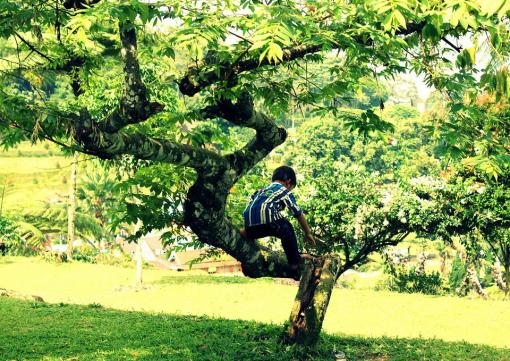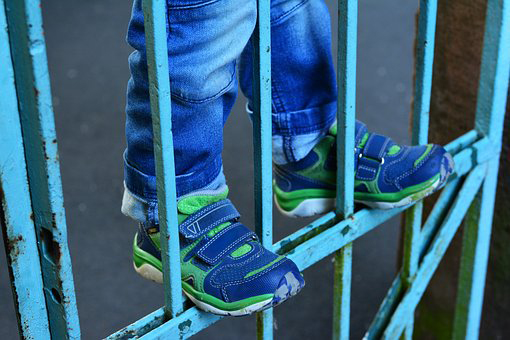“Risky play can be defined as a thrilling and exciting activity, that involves a risk of physical injury, and play that provides opportunities for challenge, testing limits, exploring boundaries and learning about risk”
Sandester 2007
In a world where some say ‘health and safety has gone mad’ and ‘in my day we … and it did us no harm’, risky play is always a hot topic in Early Years. Here are some things that have been banned from schools in the UK in recent years - in the name of health and safety:
- children unable to play with cardboard boxes (they were a fire risk!)
- children not allowed to touch each other on the playground (in case it led to a fight!)
- children not allowed to dig in the Nursery garden (because of the risk of e-coli!)
Some of them sound quite unbelievable – right? And I’m sure you’ve heard many, many more. Yet, it is so important for children to take risks – because if they don’t, they don’t learn how to manage or make decisions about risk, which in turn means they can’t take responsibility for their decisions.
That ‘what if’
When we speak to older generations, they often talk about some of the things they did ‘in their day’ and they question why children today don’t have the same experiences. The answer to this is often - fear. Not fear from the children, but fear from the adults. Children climbing trees don’t experience the same fear as the adults who are watching them – in case ‘something might happen’. This fear of ‘what if’ can become a thought in our minds that the ‘what if’ may turn into a reality.
A hazard or a risk?
Whilst it is important to keep children safe in the environments we provide for them, we must also consider the differences between ‘hazards’ and risks’ and not get these two things confused.
- a hazard is something a child does not see, it is usually dangerous and it is within our role as practitioners to identify hazards to children, talk to them about why they are dangerous and remove them
- a risk is a challenge that a child can see and chooses whether or not they want to engage in that challenge. It is when a child pushes their own boundaries and learns through firsthand experiences. If we eliminate risk it can lead to our children’s inability to assess danger
Children take risks all the time, when they ‘nearly’ fall off the climbing frame or ‘nearly’ crash the scooter into the garden gate. That ‘nearly’ part is actually children pushing their own boundaries, challenging themselves and taking risks in their play. By ‘nearly’ falling off the climbing frame they are engaging in a risk that makes part of their play enjoyable but also supports them to make decisions about how far they can go next time. It is actually a really fascinating part of their brain developing and beginning to understand managing risks for themselves.

Some things to remember
- risky play is different for all children
- part of physical development is for children to engage in play they find challenging – this usually happens when they are secure in their PSED
- lots of learning is taking place about actions & consequences and cause and effect when children engage in risky play
- if children are allowed to take risks, they learn how to manage those risks
- adult restrictions can leave children never building the confidence to try or they can lead them to creating situations where they look elsewhere for risks, away from adults, which is potentially dangerous
- ALL children are different and NOT ALL children seek out risky play, some never leave their comfort zone whereas others seek the thrill of challenging themselves more. Every child will attempt a risk they feel comfortable with and they don’t always require extensive adult supervision
The adult role in risky play
- risk assess (either visually in that moment, or written risk assessments)
- interactions – how do your interactions support risk taking? Asking questions like: ‘what might happen?’ ‘How can we tell this is safe?’ ‘Do you feel safe?’ will indicate a child’s understanding of the risk they are taking. Also, if our interactions are too negative e.g. ‘we don’t do that’, ‘stop doing that’, ‘get down’ - we are limiting opportunities for children based on our own ideas of risky play. That ‘what if’. Remember a child will usually only attempt a risk they feel comfortable with and are generally highly engaged with this activity
- modelling – showing children, playing alongside and talking to them about how to use resources safely as well as suggesting possibilities
- trust – our knowledge of our children gives us the advantage of being able to trust them. If we show we can trust them and we have modelled how to risk assess for themselves they will begin to manage their own risks
- communicating with parents – ensuring parents are aware of risk and challenge in your setting and how you are teaching children to challenge themselves but also keep themselves safe
What does this look like in practice?
- building tall structures, balancing objects that may fall
- climbing up self-built structures or climbing equipment, sometimes to a height that adults feel is “too high”
- climbing other structures such as trees or monkey bars
- rolling – either inside barrels or tyres or rolling large objects
- woodwork and toolkits
- stick play
- messy play
- knives for food preparation
- fire

Finally
We need to remember that there is a balance between a child’s need to play (even if that does involve risk) and that there is a possibility that accidents can happen when children take risks.
The word ‘risk’ appears several times throughout Development Matters, and in the Characteristics of Effective Learning. There are also many articles available on the benefits of children feeling secure to take risks in their play.
Once we begin to embrace risky play, we begin to see the benefits. We can step back and observe all the skills children are learning, such as cooperation, curiosity, confidence, decision making, resilience, independence to name a few – which begins to look very much like the Characteristics of Effective Learning.


